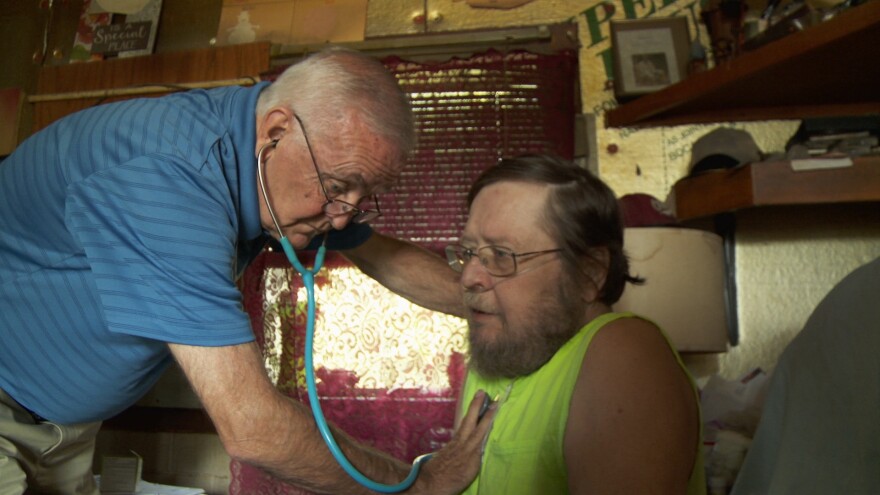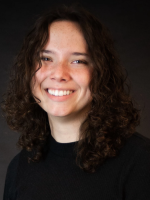Dr. James Graham is one of the few doctors left who still makes house calls. At least, that’s what one of his patients said.
Graham has practiced as a physician in Fairfax for decades, dividing his time between Fairfax’s hospital, a nursing home and three clinics, one of which is 60 miles away from the town. Over the years, he said the community’s hospital had been on the verge of closure at least 10 times. But the people he’s served – some for most of their lives – don’t change. They’re still sick and in need of care.
Graham’s story is the focus of a new documentary, “Country Doctor,” now streaming on HBO Max. It highlights the crises rural hospitals face amid provider shortages and a lack of resources. Since 2015, 108 rural hospitals have closed in the U.S. Seven of those were in Oklahoma.
Fairfax’s hospital could have been number eight. In 2019, when the documentary began, the hospital had entered bankruptcy. A skeleton crew of nurses worked without pay to staff the emergency room because, if they closed, they would not be able to reopen.
Directors and Emmy-winning filmmakers Nick Doob and Shari Cookson said they were drawn to the story and Graham, who was fighting back.
“It sounded like a story of historical importance,” Doob said.
“I mean, we hear about the problems with keeping these rural hospitals afloat and funding issues,” Cookson added. “But this was just unbelievable.”
According to reporting from the Frontier, the hospital ran out of money after insurance companies accused EmpowerHMS – a company that ran multiple hospitals in Oklahoma, including in Fairfax – of fraud. Jorge Perez, who oversaw 18 rural hospitals in eight states through EmpowerHMS, was later found guilty of fraudulently billing insurance companies for services facilities did not perform.
Cookson and Doob visited Fairfax eight times over three years. They wanted to settle in and build trust with people in town. There were no hotels, so while they filmed, they resided in a tiny house in the middle of a cow pasture.
What they found was a community that was open to telling their stories because they trusted Graham. His patients allowed them to access their appointments and medical procedures. They were welcomed back with open arms every time – even after over a year of not being able to film amid the COVID-19 pandemic.
They ate breakfast at the local diner, traded jokes with people and honored those who died during COVID during a memorial service Dr. Graham hosted.
“Those connections that we make with people, and as their story progresses, to continue to be there to follow the changes in their lives and their situations, that's very poignant for us,” Cookson said.

He was their “country doctor,” a focus Cookson and Noob were inspired by because of a landmark 1948 LIFE magazine photo essay chronicling 23 days spent with a general practitioner who served as the lone physician in a Rocky Mountain enclave covering 400 square miles.
Graham’s story, Cookson said, harkened back to that era, but also gave a modern take on a country doctor burdened by the crisis in rural health care.
“I come from Los Angeles, and my doctors may or may not remember me. It's such a big system, and it's not personal,” Cookson said. “And so that was the thing that I was the most struck by, is just the connection Dr. Graham has to his patients.”
“It made me think, ‘Gosh, that's what a doctor should be. I wish I had a doctor like this,” Cookson added.
The documentary also follows the hospital in the aftermath of its sale to a new owner. In November 2019, a bankruptcy court ruled the hospital must be put up for auction. Enter Dr. Elizabeth Pusey, a California-based radiologist who is also the founder and president of Rural Wellness, Inc. She won the bid to buy the hospital.
Community members were skeptical at first, but Pusey said she wanted to help ensure the hospital’s viability. A multi-million dollar investment was made in the facility, bringing in amenities like a system for lifting heavier patients and smart hospital beds.
“She had to figure out a business strategy that would keep the hospital afloat,” Cookson said. “The town itself doesn't really have enough of a population to support the running of the hospital, and so she knew that it was important to figure out a way to have a facility that would attract other people in from outside of the community.”
Doob said he hopes those who see the documentary get excited by it, saying they couldn’t have expected this story would have a positive ending.
“The whole direction of the film seemed to be saying, 'This is how bad it's gonna get, and it's not gonna get better,” Doob said. “And that didn't happen. That's not the way it worked.”
Cookson added that the film comes at an important time amid the current health care landscape, where facilities are now facing additional challenges, like federal cuts to Medicaid. She said rural hospitals are a lifeline for their communities, and Fairfax’s story is proof of that.
It’s also an example of how there are solutions and hope “despite it all,” she said.
“Without them, people are going to die because you can't be having a heart attack and driving a hundred miles to get to the hospital,” Cookson said. “I mean, you see the human cost that this is causing, and it's devastating. And, to see hospitals just languishing, closed down, when they are so needed – I think these images are burned in my mind of what we saw, and how much these lives are impacted.
Getting to know some of Dr. Graham's patients, you just wonder what would have happened if that hospital wasn't there,” Cookson added. “It feels very, very personal to me now.”
StateImpact Oklahoma is a partnership of Oklahoma’s public radio stations which relies on contributions from readers and listeners to fulfill its mission of public service to Oklahoma and beyond. Donate online.








